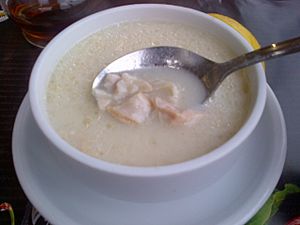Tripe soup facts for kids

Tripe soup (işkembe çorbası) from Turkey
|
|
| Course | Soup |
|---|---|
| Main ingredients | Offal (Tripe) |
Tripe soup, also known as tripe stew or tripe chorba, is a warm and hearty dish. It is a type of soup or stew made from tripe. Tripe is the edible lining from the stomach of animals like cows or lambs. This soup is popular in many parts of the world, especially in Eastern Europe, the Middle East, and Latin America.
Contents
What's in a Name?
The name for tripe soup often comes from the Turkish language. For example, in Turkish, it's called işkembe çorbası. This means "tripe soup." The word işkembe means "stomach" or "tripe." The word çorba means "soup."
Many countries near Turkey borrowed this name. In Bulgaria and Macedonia, it's called шкембе чорба (škembe čorba). In Serbia and Bosnia, it's шкембић (škembić). Albania calls it Çorbë. This shows how food names can travel across different cultures!
Tripe Soup in Europe and the Middle East
Tripe soup is a common and loved dish in many places. You can find it in the Balkan region, Eastern Europe, and the Middle East.
In Greek cuisine, tripe soup is known as patsas (πατσάς).
In Iranian cuisine, the soup is called sirabi. It can be made with tripe from calves, cows, or lambs.
Bulgaria
In Bulgaria, the soup is called škembe čorba (шкембе чорба). It is made by boiling pork, beef, or lamb tripe for several hours. The cooked tripe is then cut into small pieces and put back into the broth.
The soup gets its flavor from ground red paprika. Sometimes, a little milk is added to make it creamy. People often serve it with mashed garlic in vinegar and hot red pepper. It is a very popular and comforting dish.
Romania

The Romanian name for this sour tripe soup is ciorbă de burtă. The word ciorbă means "sour soup." This soup is often made thicker with flour, sour cream, and egg yolks. It can also be colored with fried carrots or peppers.
It is usually seasoned with vinegar, sour cream (called smântână), and a garlic dip. This garlic dip is called mujdei.
Serbia
In Serbia, tripe soup is made with fresh tripe. It is cooked with onions, garlic, and paprika. People often add fried bacon and more garlic for extra taste. Sometimes, flour is used to make the soup thicker.
Some versions of shkembe chorba in Serbia use milk. Garlic, vinegar, and chili peppers are also common seasonings.
Turkey
In Turkey, tripe chorba is called işkembe çorbası. It is usually made from cow's stomach. People often add a vinegar-garlic sauce to it at the table. Sometimes, an egg yolk-lemon juice mixture (called terbiye) is added while cooking.
Traditional restaurants that serve this soup might also offer other parts of cow and sheep offal. This includes kelle (sheep head meat). People can choose different parts of the stomach for their soup.
Tripe Soup in Central Europe
Tripe soup is also a favorite in many Central European countries.
In Croatian cuisine, it is known as Fileki, Tripice, or Vampi.
In Czech cuisine, tripe soup is called dršťková polévka. It is often shortened to dršťkovka. This soup is strongly spiced with paprika, onions, and garlic. This gives it a very distinct and spicy flavor, similar to a goulash.
In German cuisine, there are different kinds of sour tripe soup. These are found in southern parts of the country like Bavaria and Swabia. They are seasoned with ingredients like lard, onions, garlic, meat broth, and wine vinegar. Bay leaf, salt, and pepper are also used.
In Hungarian cuisine, tripe soup is called pacalleves or simply pacal. There is also a tripe stew called Pacalpörkölt, which is heavily spiced with paprika.
In Polish cuisine, tripe soup is known as flaki or flaczki.
In Slovak cuisine, it is called držková polievka.
Tripe Soup in Western and Southern Europe
You can also find tripe soup in Western and Southern Europe.
In French cuisine, tripes à la mode de Caen is a classic dish from the Normandy region.
In Italian cuisine, trippa alla fiorentina is a traditional dish from Florence. Trippa alla milanese or busecca is a traditional dish from Milan. Caldume (Italian) or quarumi (Sicilian) is a Sicilian dish. It is a veal tripe stew with vegetables, often sold as street food in Palermo and Catania.
Tripe Soup in the Americas
Tripe soup is also popular in North and South America.
In Caribbean and Latin American cuisines, tripe soup is known as sopa de mondongo.
In Mexican cuisine, menudo is a well-known tripe soup. It has a broth made with red chili pepper.
Tripe Soup in Asia
Tripe soup is enjoyed in parts of Asia too.
In Chinese cuisine, Lanzhou-style lamian noodle soup can be made with tripe.
In Indonesian cuisine, sekba or bektim is a dish that uses pork tripe and other offals. It is a type of Chinese-Indonesian dish.
In Filipino cuisine, sopa de mondongo is also eaten.
Similar Dishes
There are other dishes that are similar to tripe soup. One example is a dish made with trotters (animal feet). This dish is called pache or pacha. You can find it in Turkish, Greek, Balkan, and Eastern European cooking.













